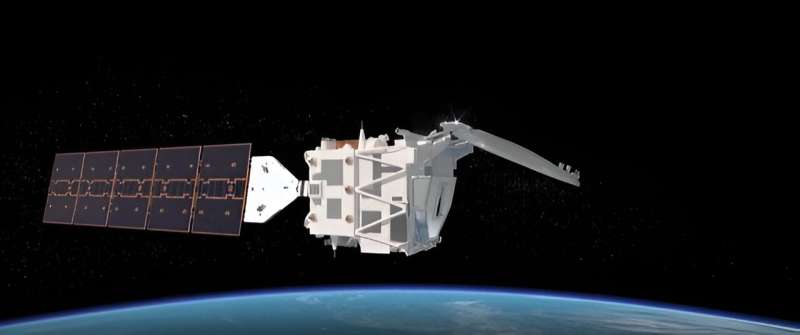This article has been reviewed according to Science X's editorial process and policies. Editors have highlighted the following attributes while ensuring the content's credibility:
fact-checked
trusted source
proofread
How will EarthCARE mission shed light on clouds?

In around six months, ESA's Earth Cloud Aerosol and Radiation Explorer mission will take to the skies to advance our understanding of the interactions between clouds, aerosols and radiation in Earth's atmosphere. But how will it do that exactly?
Clouds remain one of the biggest uncertainties in how the atmosphere drives the climate system. A better understanding of the relationship between clouds, aerosols and radiation is a high priority in both climate research and weather prediction.
For example, what happens to infrared radiation when emitted from Earth's surface and trapped by clouds? What role do aerosols play in reflecting solar radiation back to space? And how do these processes affect climate and weather?
The Earth Cloud Aerosol and Radiation Explorer (EarthCARE) mission will provide novel observations to answer some of these critical scientific questions. EarthCARE is equipped with four state-of-the-art instruments, each designed to provide unique insights into the complex interactions between clouds, aerosols and radiation.
Atmospheric lidar
The atmospheric lidar is an advanced lidar (light detection and ranging) system designed to measure the vertical profile of aerosols and clouds in Earth's atmosphere along the EarthCARE track. By emitting light pulses and analyzing the reflected signals, this unique lidar can precisely provide the distribution and properties of aerosols and clouds, including their altitude, thickness and detailed optical properties and aerosol type. This information is crucial for improving climate models and understanding the role of aerosols and clouds in Earth's energy balance.
Cloud profiling radar
Provided by the Japanese Space Agency (JAXA), the cloud profiling radar is a key instrument that enables EarthCARE to observe the internal structure of clouds. Operating in the millimeter-wavelength range, the cloud profiling radar penetrates through clouds and light precipitation—providing detailed insights into their vertical structure and velocity, particle size distribution and water content. This radar is essential for studying cloud processes, such as the formation and dissipation of clouds, and contributes valuable data for improving weather and climate models.
Multispectral imager
Whereas the lidar and radar will provide profiles of the atmosphere in a rather thin curtain, directly underneath the satellite, EarthCARE's multispectral imager provides a much wide field of view to give context to the profile measurements.
The multispectral imager captures high-resolution images in multiple spectral bands in the visible and infrared spectrum, which will allow scientists to differentiate between various types of clouds, aerosols and Earth's surface.
The imager provides additional information about the optical properties of clouds and aerosols, aiding in the characterization of their composition and distribution. In addition, it will allow the generation of a three-dimensional cloud and aerosol field using the atmospheric lidar and cloud profiling radar data. These data are crucial for understanding the radiative impact of clouds and aerosols on Earth's climate system.
Broadband radiometer
The broadband radiometer plays a crucial role in EarthCARE's mission by measuring the radiative fluxes at the top of Earth's atmosphere. As the satellite travels along its orbit, the radiometer views the atmosphere from three directions, allowing it to accurately quantify the amount of reflected solar radiation and the outgoing thermal radiation emitted by Earth.
This is known as the planet's energy balance. Comparing this to the radiation calculated from the combined observations of the other instruments will help scientists improve our current understanding of the aerosol-cloud-radiation interaction.
Together, these four instruments form a powerful suite of tools that provide unprecedented observations of Earth's atmosphere. The data generated by EarthCARE's instruments contribute significantly to advancing our knowledge of climate processes and will unravel the intricate interactions between clouds, aerosols and radiation in Earth's atmosphere.
Largest and most complex Earth Explorer mission
EarthCARE is the largest and most complex Earth Explorer, developed within ESA's Earth Observation FutureEO program. The mission comes at a critical time in the development of kilometer-scale resolution, global climate models and will provide an important contribution to an improved understanding of cloud convection and its role in Earth's radiation budget.
EarthCARE is an ESA mission, but it has been developed as a cooperation between ESA and JAXA, the Japanese Space Agency.
As the international science community eagerly awaits the valuable data from the EarthCARE satellite, researchers and experts from the field gathered at ESA's Center for Earth Observation in Frascati, Italy, to present and discuss EarthCARE science topics and validation of the mission data.
As EarthCARE's launch approaches, the growing excitement is being felt across the community. The central role of the mission in ensuring long-term, climate-relevant datasets, in synergy with past and future missions, was also clearly identified.
Provided by European Space Agency




















